How to Calculate LED Screen Size
Table of Contents
Understanding the correct LED screen size is crucial for delivering clear visuals and maximum audience engagement. The size of an LED screen is determined by its physical dimensions, while pixel pitch and resolution control clarity. Whether planning a small indoor display, a home theater setup, or a large outdoor LED wall, selecting the right LED screen size ensures that every detail is visible, proportionate, and impactful. This guide covers practical methods for calculating screen dimensions, factors affecting screen selection, and industry standards, providing a global perspective for all event types and venues.
1. What Is LED Screen Size?
The size of LED screen refers to its physical dimensions, typically measured in width × height (e.g., mm, meters, or inches). It’s important to distinguish the LED screen display size from its resolution—the latter determines pixel density, not the physical size.
Custom size LED screens are designed to meet specific needs, such as unique event setups or advertising displays. For larger venues, choosing the big LED screen size is essential to ensure visibility from a distance. In these cases, the LED wall screen size plays a crucial role in determining the overall impact.
When calculating LED screen size, consider both the LED panel screen size and the number of panels used. The LED screen sizes in mm provide precise measurements, helping you select the correct setup. Standard sizes, like 16:9 or 4:3 aspect ratios, are commonly used, but certain industries or locations might require custom configurations based on local standards, such as IEC, ISO, or FCC guidelines.
For example, in large-scale outdoor events or advertising campaigns, the LED screen size is carefully selected based on the viewing distance and the space’s scale. This ensures maximum visibility and engagement. Understanding the difference between LED screen sizes and pixel count helps ensure you choose a screen that balances visual clarity with size, tailored to your specific environment.
Doing the math can be tricky. If you just want the result without the headache, Contact UnifyLED Engineers. Give us your wall dimensions (Height & Width), and we will send you a Free Cabinet Layout Design within 1 hour.
2. Key Factors That Affect LED Screen Size Selection
Choosing the right LED screen size depends on multiple factors, including viewing distance, pixel pitch, installation environment, content type, and budget. Understanding these factors ensures optimal visibility, clarity, and audience experience.
Viewing Distance

Viewing distance is the primary factor in determining LED wall screen size. Short-range environments, like retail displays, control rooms, or product showcases, require smaller screens with fine pixel pitch for clear detail. Long-range setups, such as outdoor LED billboards or stadiums, need larger screens to maintain visibility.
Regional differences in viewing distance preferences:
|
Region |
Typical Use |
Recommended LED Screen Size |
Pixel Pitch |
|
North America |
Stadiums, large outdoor advertising |
Large-format LED walls |
P4–P6 |
|
Europe |
Outdoor signage, high-traffic areas |
Medium to large walls |
P3–P4 |
|
Asia / Southeast Asia |
Indoor retail, exhibitions |
Small to medium screens |
P1.5–P3 |
Practical formula for reference:
Comfortable viewing distance ≈ Pixel Pitch (mm) × 1,000–1,500
Pixel Pitch & Resolution
Pixel pitch determines the clarity of a screen at a given size and distance. Smaller pitch improves close-range detail but increases cost. Properly matching pixel pitch and resolution prevents pixel waste and ensures clear visuals.
Resolution suitability index (ERI):
ERI ≥ 800 → Suitable for close-range content
ERI 500–800 → Suitable for mid-range events
ERI < 500 → Best for long-range outdoor viewing
Example: P2 or P3 is common in North American stadiums for closer seating, while P1.5–P2 is preferred in Asian retail for sharp, close-range visuals.
Choosing the right resolution is tricky. Check out our comparison guide on P2.6 vs P3.91 to make the right choice.
Installation Environment
The environment affects LED display screen sizes, brightness, and durability. Indoor installations typically require lower LED screenbrightness, smaller pixel pitch, and lighter cabinets, with custom size LED screens often used to maximize space efficiency. Outdoor installations need weatherproof, high-brightness panels, and larger LED wall screen sizes for visibility from long distances. Rental and touring setups benefit from modular LED panels for flexible stage configurations.
Environmental requirements vary by region. In the Middle East, extreme heat and sunlight require displays with high IP ratings and heat-resistant components. In Southeast Asia, high humidity demands corrosion-proof and well-sealed screens. In North America, energy efficiency standards and brightness regulations influence outdoor LED screen design and sizing.
Content Type
The type of content influences LED screen display size and aspect ratio:
Video advertising: 16:9 or portrait formats
IMAG/live events: 16:9 for camera alignment
Control rooms/data visualization: 4:3 or hybrid formats
Experiential marketing/cinema: 21:9 or custom shapes
Matching screen size to content avoids distortion or wasted space. Regions like Europe and Japan increasingly use custom size LED screens for immersive brand experiences.
Budget & Structural Support
Larger LED panel screen sizes increase costs due to more cabinets, higher power needs, and structural support. Consider:
Cabinet quantity → affects cost escalation
Power load → ensures circuit reliability
Structural capacity → supports wall, truss, or floor-mounted screens
Accessibility → space for installation and maintenance
Standard LED screen sizes simplify planning and reduce custom costs, while custom size LED screens are preferred for specialized layouts or unique environmental requirements. Calculating the physical size is only step one. You also need to ensure your total pixel count matches your video source (like 1920×1080). Learn more about how to calculate LED display resolution here.
3. How to Calculate LED Screen Size
Understanding the correct LED screen size is essential before starting any project. Whether you are planning a small indoor display or a big LED screen size for outdoor advertising, accurate calculation ensures the right viewing effect and installation layout. These three proven methods help determine the most suitable LED display screen sizes, including fully custom size LED screen builds and standard configurations.
Method 1 – Module Size × Quantity
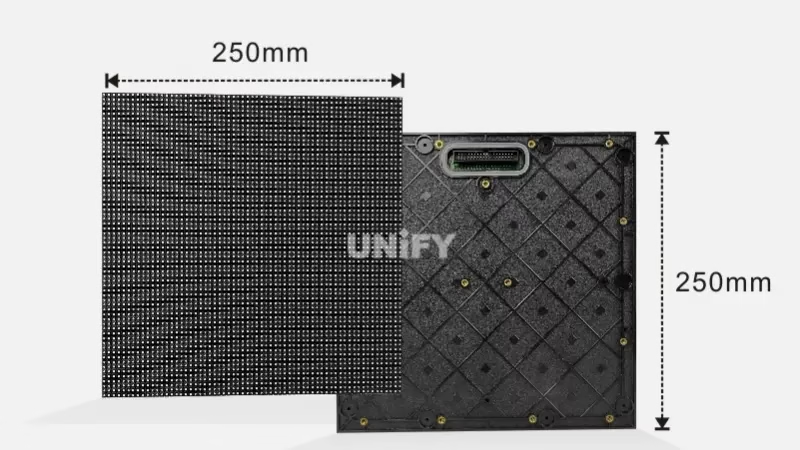
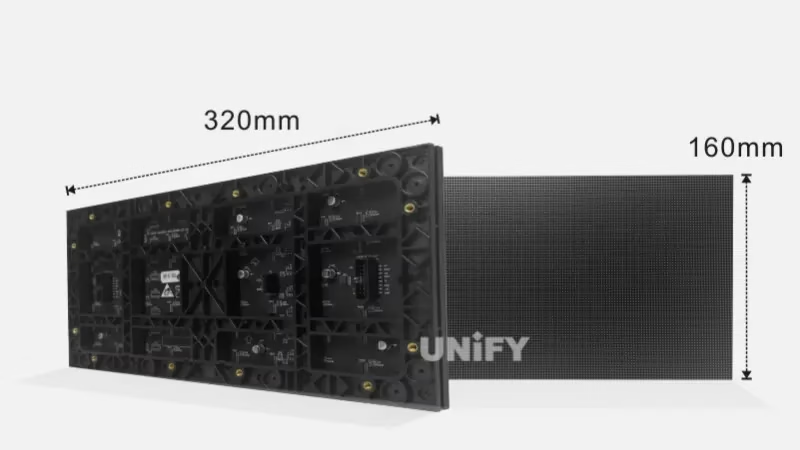
The module method is the most widely used for calculating LED screen sizes in mm, especially when creating a custom size LED screen or an irregular display.
Common LED Module Sizes
|
Module Type |
Size (mm) |
|
250 × 250 mm |
Square module |
|
320 × 160 mm |
Indoor standard |
|
192 × 192 mm |
Fine-pitch module |
Formula
Total Width = Module Width × Horizontal Quantity
Total Height = Module Height × Vertical Quantity
Best For
Creative shapes and flexible size LED screen layouts
Custom indoor displays
Fine-pitch installations
This method allows you to build any LED panel screen size or unique LED screen display size based on project needs.
Method 2 – Cabinet Size × Quantity (LED Screen Cabinet Method)
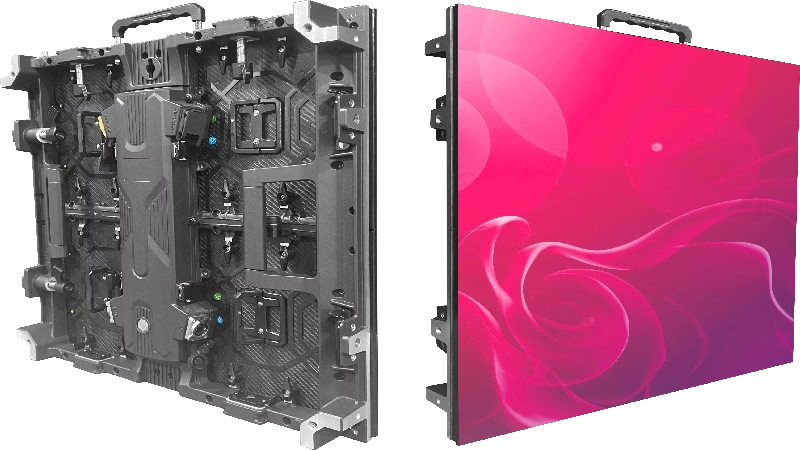
For many outdoor and rental projects, the LED screen cabinet becomes the core unit for calculating screen size. Cabinets offer standardized structural strength, simplified installation, and consistent alignment.
Common LED Screen Cabinet Sizes
|
LED Screen Cabinet Type |
Size (mm) |
|
500 × 500 mm |
Rental and stage applications |
|
640 × 480 mm |
Indoor fine-pitch cabinet |
|
960 × 960 mm |
Outdoor fixed installation |
Formula
Screen Width = Cabinet Width × Number of Horizontal Cabinets
Screen Height = Cabinet Height × Number of Vertical Cabinets
Best For
Outdoor billboards and fixed advertising
Rental events requiring fast setup
Large LED wall screen size projects
Standardized led screen standard sizes using pre-designed cabinets
Because each LED screen cabinet maintains uniform dimensions, this method creates consistent and stable structures for led wall screen size builds.
Method 3 – Resolution × Pixel Pitch
This method calculates the size of LED screen based on the display’s resolution and pixel pitch, making it the most precise approach.
Formula
Width (mm) = Horizontal Pixels × Pixel Pitch (mm)
Height (mm) = Vertical Pixels × Pixel Pitch (mm)
Advantages
Precise LED screen size calculation
Full control over brightness, clarity, and resolution
Ideal for high-end installations where detail matters
Helps define accurate LED screen standard sizes
Example Table
Resolution | Pixel Pitch (mm) | Final Screen Dimensions |
1920 × 1080 | 1.2 mm | 2304 mm × 1296 mm |
1280 × 720 | 2.5 mm | 3200 mm × 1800 mm |
3840 × 2160 | 1.5 mm | 5760 mm × 3240 mm |
Comparison of the 3 Methods
|
Method |
Pros |
Cons |
Best For |
|
Module Size × Quantity |
Flexible, ideal for custom size LED screen |
Size increments depend on module dimensions |
Indoor screens, creative shapes |
|
Cabinet Size × Quantity (LED Screen Cabinet) |
Strong structure, fast installation, consistent alignment |
Less flexible for custom shapes |
Outdoor advertising, rental LED walls |
|
Resolution × Pixel Pitch |
Most accurate control over led screen display size |
Requires resolution planning |
Control rooms, commercial fine-pitch displays |
Different applications also influence the ideal LED screen size. Indoor retail and meeting rooms usually use smaller fine-pitch displays, while outdoor advertising often requires much larger screens built with standard LED screen cabinet configurations. Event stages prefer flexible rental sizes, and control rooms rely on precise pixel-pitch calculations for wide, high-resolution layouts.
4. LED Screen Size for Event
Choosing the right LED screen size for event is critical for visibility, audience engagement, and visual impact. Different event types—weddings, stages, conference rooms, outdoor advertising, and home theaters—have unique requirements for size, pixel pitch, and viewing distance. Based on over a decade of LED installations worldwide, this guide provides practical recommendations, pricing considerations, and methods to check screen dimensions, tailored for global audiences.
LED Screen Size for Wedding

Weddings often use LED screens for live feeds, decorative video walls, or background visuals. The ideal LED screen wall size depends on venue size, audience distance, and screen placement.
Small indoor weddings (Asia): 2 × 1.5 m, 2–3 mm pixel pitch; US/Europe equivalent: 6.5 × 5 ft.
Medium halls (Asia): 4 × 2.5 m, 3–4 mm pixel pitch; US/Europe: 13 × 8 ft.
Large venues: 6 × 3 m, 4–6 mm pixel pitch; US/Europe: 20 × 10 ft.
Using custom size LED screens ensures flexibility for unusual layouts or curved stages. Matching LED screen size and viewing distance is essential so all guests can clearly see images. Modular LED screen cabinets simplify installation and maintenance while helping control costs .
LED Screen Size for Stage
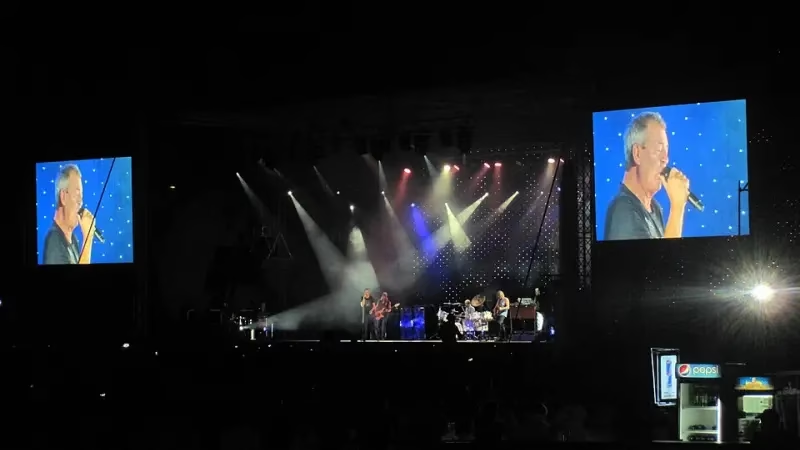
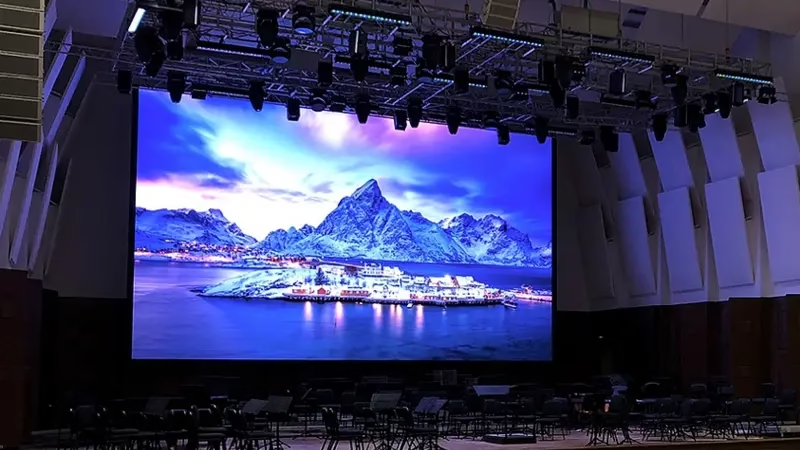
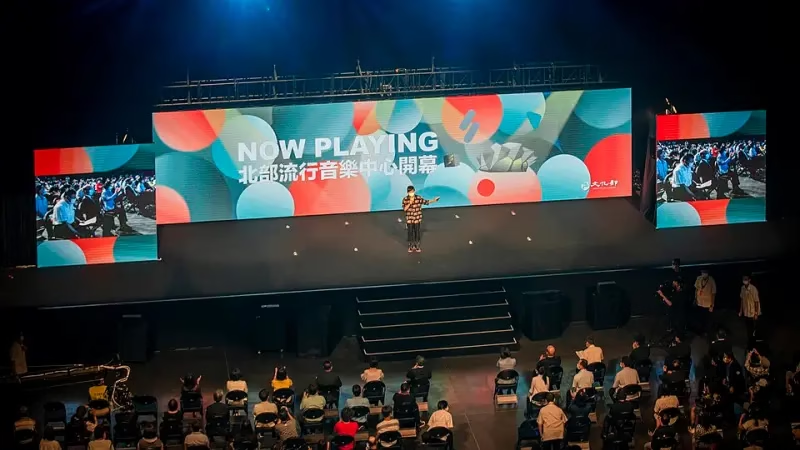
Stage setups, including concerts, corporate events, and theater performances, require high-impact screens visible to large audiences.
Main stage screens: 6 × 4 m, 3–6 mm pixel pitch.
Side or auxiliary screens: 3 × 2 m, 3–5 mm pixel pitch.
IMAG / close-up screens: 2 × 1.5 m, 2–4 mm pixel pitch.
Experience shows that modular LED screen cabinets allow quick assembly and consistent alignment. Custom size LED screens help fit unusual stage layouts and optimize sightlines. Correct LED screen size and viewing distance ensures clarity across the audience, and using standard cabinets keeps costs predictable.
LED Screen Size for Conference Room
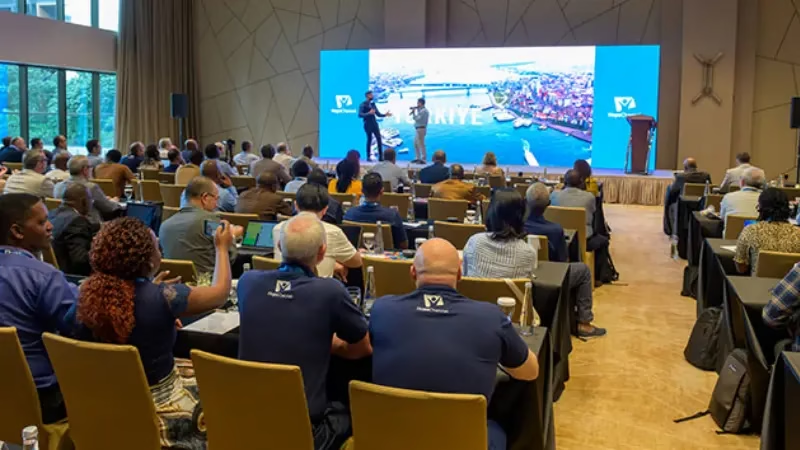
Conference rooms require medium-sized, fine-pitch screens to display presentations, video calls, and dashboards.
Small rooms (Asia): 1.2 × 0.9 m, 1.5–2 mm pixel pitch; US/Europe: 4 × 3 ft.
Medium rooms: 2.5 × 1.5 m, 1.5 mm pitch; 8 × 5 ft.
Large boardrooms / auditoriums: 4.5 × 2.5 m, 2–2.5 mm pitch; 15 × 8 ft.
Modular or custom size LED screens help adapt to unusual room layouts. Proper LED screen size and viewing distance ensures all participants can clearly see content. Always measure the wall and verify dimensions before installation.
LED Screen Size for Outdoor Advertising
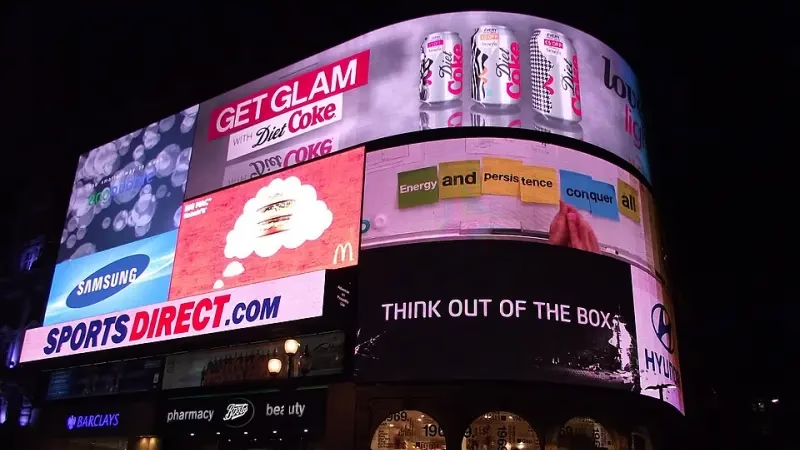
Outdoor LED walls require larger sizes and durable, weather-resistant setups. Viewing distance is the primary factor in determining LED screen wall size.
Small billboards: 3 × 2 m, 6–10 mm pixel pitch; US/Europe: 10 × 6 ft.
Mall signage: 4 × 3 m, 5–8 mm pitch; 13 × 10 ft.
Stadium / sports walls: 10 × 6 m, 8–16 mm pitch; 33 × 20 ft.
Modular LED screen cabinets simplify assembly and maintenance. Custom size LED screens allow adaptation to irregular surfaces. Always consider LED screen size and viewing distance to match expected audience distance, and calculate costs upfront .
LED Screen Size for Home Theater Setup
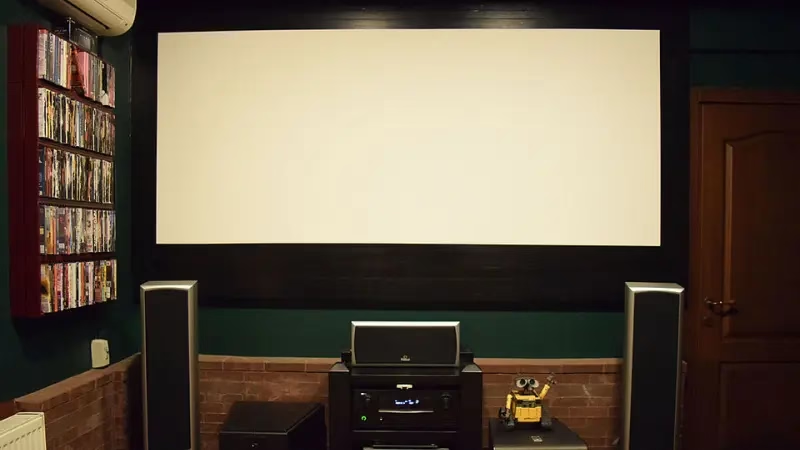
Home theaters prioritize high-resolution, close-viewing clarity.
Small rooms: 1.5 × 0.9 m, 1.2–1.5 mm pitch; 5 × 3 ft.
Medium rooms: 2 × 1.2 m, 1.5 mm pitch; 6.5 × 4 ft.
Large home theaters: 3 × 2 m, 1.5–2 mm pitch; 10 × 6 ft.
Using custom size LED screens ensures proper fit in non-standard rooms. Matching LED screen size and viewing distance avoids eye strain and maintains visual quality. Modular LED screen cabinets allow easier setup and future upgrades.
Selecting the right LED screen size for event requires considering application type, venue size, viewing distance, and budget. Indoor events like weddings and conference rooms require fine-pitch, medium-sized screens, stage events benefit from modular large screens, outdoor advertising demands high-visibility, weather-resistant walls, and home theaters prioritize close-range clarity. Always measure dimensions accurately and plan for LED screen size and price. Modular LED screen cabinets or custom size LED screens offer flexibility for all event types.
5. Common Mistakes When Choosing LED Screen Size
Selecting the right LED screen size is essential for visual impact and clarity. Many event organizers make mistakes that can compromise the display’s effectiveness. Understanding these common pitfalls ensures your LED wall screen size meets expectations.
Resolution Mismatch
hoosing a big LED screen size without matching resolution results in pixelated images, especially for close viewing. Considering LED panel screen size and pixel pitch helps maintain image clarity. Proper planning of LED display screen sizes ensures visuals remain sharp and professional.
Insufficient Installation Space
Oversized screens may not fit walls or stage areas. Custom size LED screens are sometimes required to adapt to unusual layouts. Checking available space carefully helps avoid installation issues and ensures the planned LED screen sizes are achievable.
Content Proportion Mismatch
Using content designed for a standard aspect ratio on a screen with a different proportion can cause stretching or cropping. Planning content according to LED screen standard sizes or LED screen display size ensures visuals remain proportional and professional.
Ignoring Structural and Environmental Factors
Large LED wall screen sizes require sufficient structural support. Outdoor screens must withstand wind, rain, and temperature changes. Reviewing specifications for LED screen sizes in mm and cabinet construction is critical for safety and longevity.
By avoiding these mistakes, you can optimize the size of LED screen and select appropriate LED screen sizes, ensuring your installation meets both visual and practical requirements.
6. LED Screen Cabinet FAQs
To determine the right LED screen size, consider viewing distance, content type, and installation space. Common methods include calculating based on module or cabinet dimensions, or using resolution × pixel pitch to match the intended display area.
For indoor applications, smaller pixel pitch provides higher clarity. Fine-pitch screens (1.5–2.5 mm) are suitable for close-viewing areas like conference rooms or home theaters, while larger pitches (3–4 mm) work for medium halls or event spaces.
UnifyLED (unifyled.com) and ledscreenfactory.com provide custom size LED screens suitable for retail, including adjustable dimensions and modular configurations.
Both UnifyLED and ledscreenfactory.com supply LED panels in the 50–100 inch range, suitable for indoor signage, events, or smaller video walls.
7. Conclusion
Choosing the right LED screen size depends on viewing distance, pixel pitch, content, and environment. Indoor events, stages, outdoor advertising, and home theaters all have unique requirements. Working with a professional LED screen factory ensures the right size, custom options, and modular solutions for optimal visibility and impact.
Still not sure if your calculated size fits your budget?
👉Get a Quote for Your Size: Download our 2025 Price List for standard 500x500mm and 500x1000mm cabinets to estimate your cost instantly.
8. Recommend
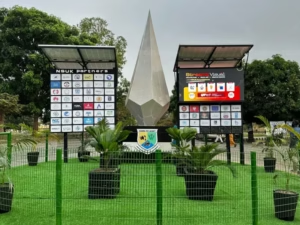
Nits vs. Lumens: Why Your Projector Can’t Beat an LED Screen?
Nits vs. Lumens: Demystifying brightness. See why LED screens beat high-lumen projectors in daylight. Learn the key difference and choose the right display.
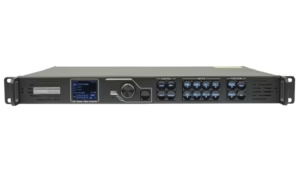
LED Video Processor Guide: Functions, Tips & Top Models
Learn how a led video processor enhances your screen. Explore functions, selection tips, and top Novastar VX vs Huidu VP recommendations.

LED Display Power Consumption Guide: Watts, Amps & Cost Calculator
Master led display power consumption calculations. Learn the real difference between Max vs. Average watts and save your budget.
